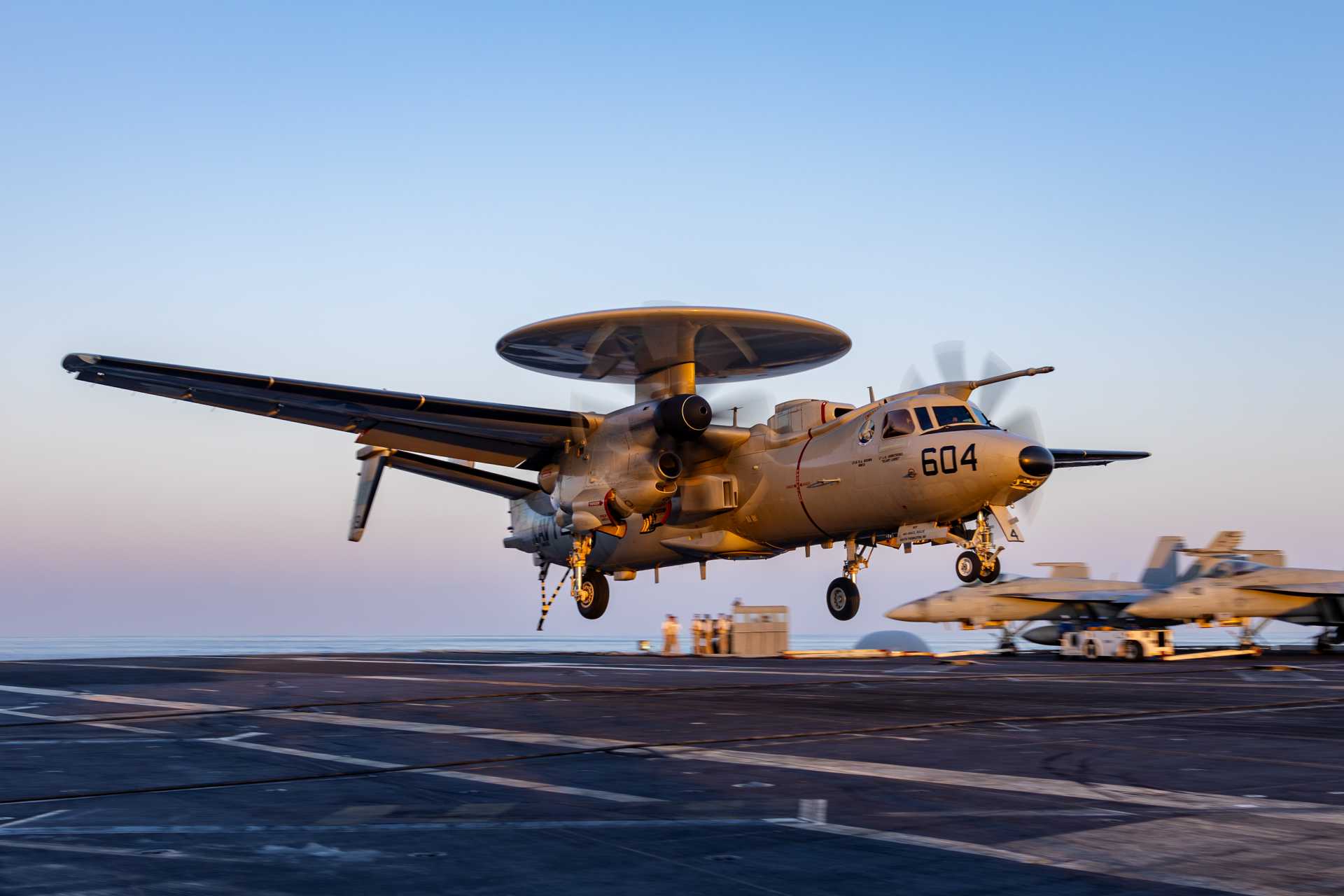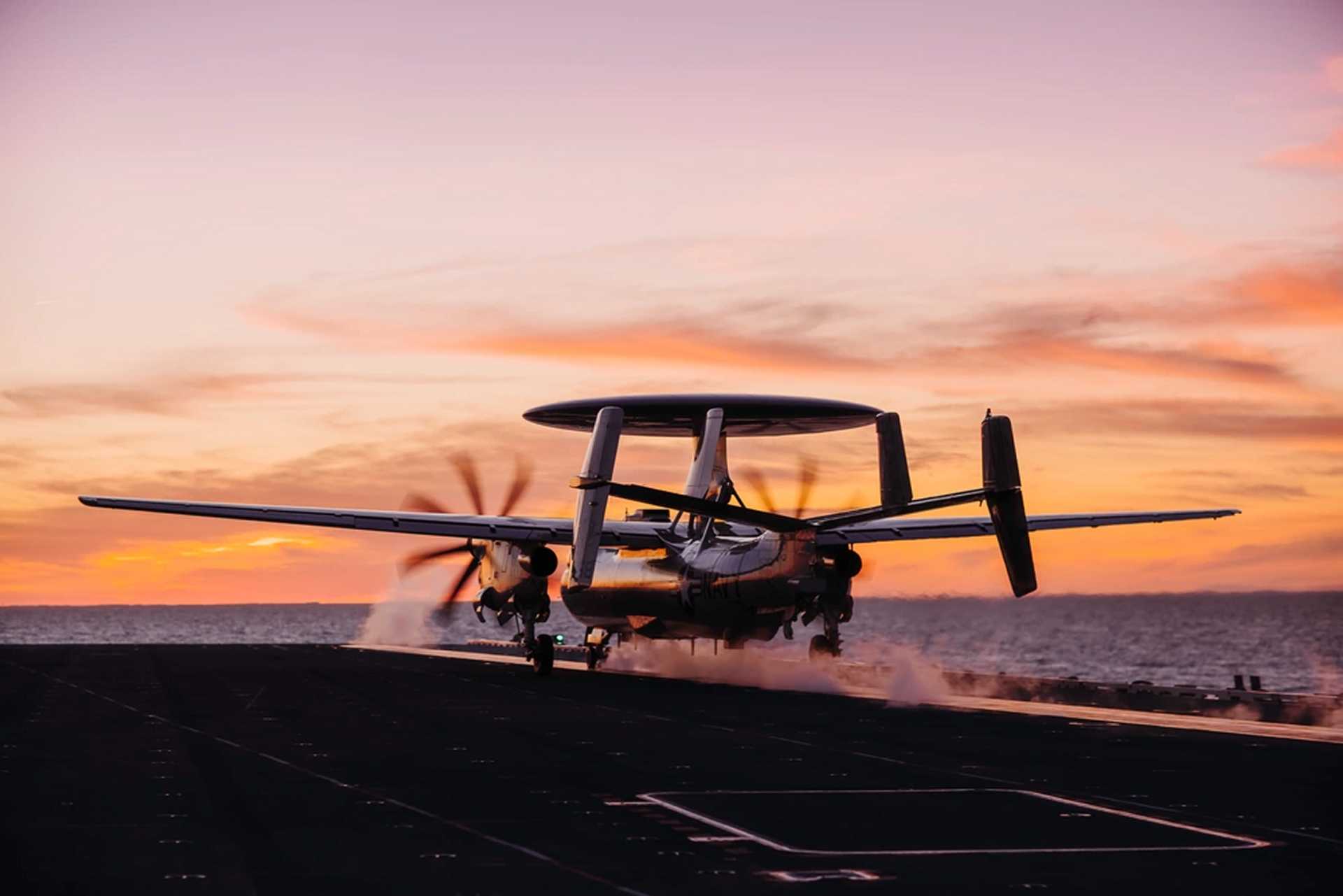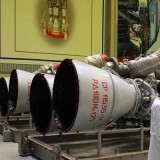Taiwan wants six E-2D Advanced Hawkeye early warning aircraft from the US to track new Chinese stealth fighters

{loadposition bannertop}
{loadposition sidebarpub}
According to CNA on February 4, 2025, Taiwan plans to acquire six E-2D Advanced Hawkeye early warning aircraft from the United States to replace its current fleet of E-2K aircraft. This decision follows an increase in Chinese military activity extending into Taiwan’s eastern region, prompting concerns over existing airborne early warning capabilities. The E-2D, which is currently in service with the U.S. Navy and Japan, is expected to improve Taiwan’s ability to detect and track Chinese stealth fighters, which the Chinese Air Force is increasingly deploying in the region.Follow Army Recognition on Google News at this link
Taiwan’s growing need for extended aerial surveillance has led the country to reconsider the purchase of the E-2D, as its phased array radar offers superior detection capabilities compared to its older E-2K. (Picture source: US Navy)
Taiwan’s Air Force operates six E-2K early warning aircraft, an upgraded version of the older E-2T. Four of these aircraft were originally acquired in 1995 and modernized in 2013, while the remaining two were purchased in 1999 and entered service in 2005. However, in November 2022, an E-2K (serial number 2503) was damaged during a belly landing at Pingtung Air Base due to the landing gear failing to deploy. The Control Yuan reviewed the case, highlighting issues related to fleet maintenance. Taiwan is now seeking to replace these aircraft with more modern E-2Ds, which incorporate updated radar and surveillance systems.
For several years, Taiwan explored the possibility of acquiring the E-2D but initially decided against it due to the availability of land-based radar systems. However, these systems have detection limitations caused by the Earth’s curvature, particularly against low-altitude and stealth aircraft. The increasing frequency of Chinese aerial operations, including the deployment of J-20, J-20S, and J-35 stealth fighters, as well as the unveiling of the J-15T and J-15D, has prompted Taiwan to reassess its early warning requirements. Consequently, Taiwan’s growing need for extended aerial surveillance has led the country to reconsider the purchase of the E-2D. Its phased array radar offers superior detection capabilities compared to the E-2K’s mechanically scanned radar, extending its tracking range to over 550 kilometers. This enhancement is particularly valuable in countering stealth aircraft, which rely on reduced radar cross-sections to evade detection.
The timing of the acquisition is influenced by production availability, as Japan has already placed orders for the E-2D, and securing aircraft now may align with existing production schedules. Sources indicate that Taiwan’s total requirement remains at six aircraft, with specific operational details yet to be disclosed. Officials state that the procurement is based on operational needs. This acquisition is part of Taiwan’s broader defense planning, as recent reports suggest that the Taiwanese Navy is considering acquiring MH-60R anti-submarine helicopters, and the Army is moving forward with plans to procure M109A7 self-propelled howitzers. The Ministry of National Defense responded to inquiries by reaffirming that detailed information on military acquisitions will not be disclosed until formal agreements are finalized and budget allocations are secured.
Under the Navy’s Naval Integrated Fire Control – Counter Air (NIFC-CA) concept, the E-2D is designed to guide AIM-120 AMRAAM and SM-6 missiles beyond a launch platform’s sensor range. (Picture source: US DoD)
The E-2 Hawkeye program was initiated in the 1950s when the U.S. Navy sought an airborne early warning aircraft. Developed by Grumman (now Northrop Grumman), the E-2 made its first flight in 1960 and entered service in 1964. It was designed from the outset as a carrier-based airborne early warning platform rather than as a modification of an existing aircraft. The platform has undergone multiple upgrades, progressing from the E-2A to the E-2B and E-2C, leading to the current E-2D. The aircraft is operated by the United States, France, Japan, Egypt, Mexico, Singapore, and Taiwan.
The E-2D Advanced Hawkeye early warning aircraft is the latest version of the E-2 series, incorporating an updated avionics suite, the AN/APY-9 radar, a new radio suite, mission computer, integrated satellite communications, improved T56-A-427A engines, a glass cockpit, and aerial refueling capability. The APY-9 radar is an active electronically scanned array (AESA) system that combines electronic scanning with mechanical rotation and operates in the UHF band, which has the potential for detecting stealth aircraft optimized against higher-frequency bands. The aircraft allows the co-pilot to function as a “Tactical 4th Operator” (T4O) with access to radar, IFF, Link 16 (JTIDS)/CEC, and mission data. Under the Navy’s Naval Integrated Fire Control – Counter Air (NIFC-CA) concept, the E-2D is designed to guide AIM-120 AMRAAM and SM-6 missiles beyond a launch platform’s sensor range.
Initial production deliveries started in 2010, with the first carrier landing conducted on February 4, 2010, aboard the USS Harry S. Truman. The aircraft was successfully launched via the Electromagnetic Aircraft Launch System (EMALS) on September 27, 2011. Full-rate production was approved on February 12, 2013, and by mid-2013, ten units had been delivered, with additional aircraft in production. Northrop Grumman received contracts in 2013 and 2014 for a total of 50 aircraft, with the first deliveries featuring aerial refueling capability beginning in September 2019. A modification introduced in 2016 enables the E-2D to extend its station time to five hours and total mission endurance to seven hours, with retrofitting planned for earlier units.
Replacing the earlier E-2C, the E-2D is powered by two Rolls-Royce T56-A-427A turboprop engines, allowing it to reach a maximum speed of over 300 knots and an altitude of up to 37,000 feet. It includes a fully integrated open-architecture mission system and provides continuous 360-degree radar coverage. The crew consists of five members—two pilots and three mission system operators, with the co-pilot capable of serving as an additional operator. The aircraft can track more than 3,000 targets simultaneously and relay data to air and missile defense systems. It is designed for command and control operations and is compatible with U.S. and NATO networks, which explains why the U.S. Navy has ranked the E-2D among its key acquisition programs in recent years.

{loadposition bannertop}
{loadposition sidebarpub}
According to CNA on February 4, 2025, Taiwan plans to acquire six E-2D Advanced Hawkeye early warning aircraft from the United States to replace its current fleet of E-2K aircraft. This decision follows an increase in Chinese military activity extending into Taiwan’s eastern region, prompting concerns over existing airborne early warning capabilities. The E-2D, which is currently in service with the U.S. Navy and Japan, is expected to improve Taiwan’s ability to detect and track Chinese stealth fighters, which the Chinese Air Force is increasingly deploying in the region.
Follow Army Recognition on Google News at this link
Taiwan’s growing need for extended aerial surveillance has led the country to reconsider the purchase of the E-2D, as its phased array radar offers superior detection capabilities compared to its older E-2K. (Picture source: US Navy)
Taiwan’s Air Force operates six E-2K early warning aircraft, an upgraded version of the older E-2T. Four of these aircraft were originally acquired in 1995 and modernized in 2013, while the remaining two were purchased in 1999 and entered service in 2005. However, in November 2022, an E-2K (serial number 2503) was damaged during a belly landing at Pingtung Air Base due to the landing gear failing to deploy. The Control Yuan reviewed the case, highlighting issues related to fleet maintenance. Taiwan is now seeking to replace these aircraft with more modern E-2Ds, which incorporate updated radar and surveillance systems.
For several years, Taiwan explored the possibility of acquiring the E-2D but initially decided against it due to the availability of land-based radar systems. However, these systems have detection limitations caused by the Earth’s curvature, particularly against low-altitude and stealth aircraft. The increasing frequency of Chinese aerial operations, including the deployment of J-20, J-20S, and J-35 stealth fighters, as well as the unveiling of the J-15T and J-15D, has prompted Taiwan to reassess its early warning requirements. Consequently, Taiwan’s growing need for extended aerial surveillance has led the country to reconsider the purchase of the E-2D. Its phased array radar offers superior detection capabilities compared to the E-2K’s mechanically scanned radar, extending its tracking range to over 550 kilometers. This enhancement is particularly valuable in countering stealth aircraft, which rely on reduced radar cross-sections to evade detection.
The timing of the acquisition is influenced by production availability, as Japan has already placed orders for the E-2D, and securing aircraft now may align with existing production schedules. Sources indicate that Taiwan’s total requirement remains at six aircraft, with specific operational details yet to be disclosed. Officials state that the procurement is based on operational needs. This acquisition is part of Taiwan’s broader defense planning, as recent reports suggest that the Taiwanese Navy is considering acquiring MH-60R anti-submarine helicopters, and the Army is moving forward with plans to procure M109A7 self-propelled howitzers. The Ministry of National Defense responded to inquiries by reaffirming that detailed information on military acquisitions will not be disclosed until formal agreements are finalized and budget allocations are secured.

Under the Navy’s Naval Integrated Fire Control – Counter Air (NIFC-CA) concept, the E-2D is designed to guide AIM-120 AMRAAM and SM-6 missiles beyond a launch platform’s sensor range. (Picture source: US DoD)
The E-2 Hawkeye program was initiated in the 1950s when the U.S. Navy sought an airborne early warning aircraft. Developed by Grumman (now Northrop Grumman), the E-2 made its first flight in 1960 and entered service in 1964. It was designed from the outset as a carrier-based airborne early warning platform rather than as a modification of an existing aircraft. The platform has undergone multiple upgrades, progressing from the E-2A to the E-2B and E-2C, leading to the current E-2D. The aircraft is operated by the United States, France, Japan, Egypt, Mexico, Singapore, and Taiwan.
The E-2D Advanced Hawkeye early warning aircraft is the latest version of the E-2 series, incorporating an updated avionics suite, the AN/APY-9 radar, a new radio suite, mission computer, integrated satellite communications, improved T56-A-427A engines, a glass cockpit, and aerial refueling capability. The APY-9 radar is an active electronically scanned array (AESA) system that combines electronic scanning with mechanical rotation and operates in the UHF band, which has the potential for detecting stealth aircraft optimized against higher-frequency bands. The aircraft allows the co-pilot to function as a “Tactical 4th Operator” (T4O) with access to radar, IFF, Link 16 (JTIDS)/CEC, and mission data. Under the Navy’s Naval Integrated Fire Control – Counter Air (NIFC-CA) concept, the E-2D is designed to guide AIM-120 AMRAAM and SM-6 missiles beyond a launch platform’s sensor range.
Initial production deliveries started in 2010, with the first carrier landing conducted on February 4, 2010, aboard the USS Harry S. Truman. The aircraft was successfully launched via the Electromagnetic Aircraft Launch System (EMALS) on September 27, 2011. Full-rate production was approved on February 12, 2013, and by mid-2013, ten units had been delivered, with additional aircraft in production. Northrop Grumman received contracts in 2013 and 2014 for a total of 50 aircraft, with the first deliveries featuring aerial refueling capability beginning in September 2019. A modification introduced in 2016 enables the E-2D to extend its station time to five hours and total mission endurance to seven hours, with retrofitting planned for earlier units.
Replacing the earlier E-2C, the E-2D is powered by two Rolls-Royce T56-A-427A turboprop engines, allowing it to reach a maximum speed of over 300 knots and an altitude of up to 37,000 feet. It includes a fully integrated open-architecture mission system and provides continuous 360-degree radar coverage. The crew consists of five members—two pilots and three mission system operators, with the co-pilot capable of serving as an additional operator. The aircraft can track more than 3,000 targets simultaneously and relay data to air and missile defense systems. It is designed for command and control operations and is compatible with U.S. and NATO networks, which explains why the U.S. Navy has ranked the E-2D among its key acquisition programs in recent years.




